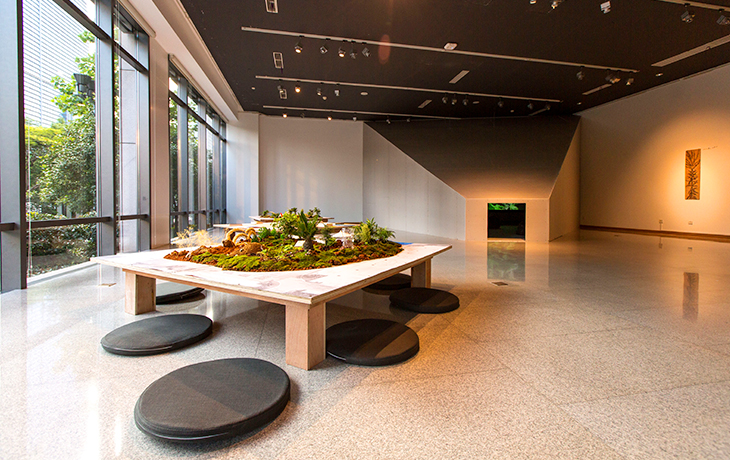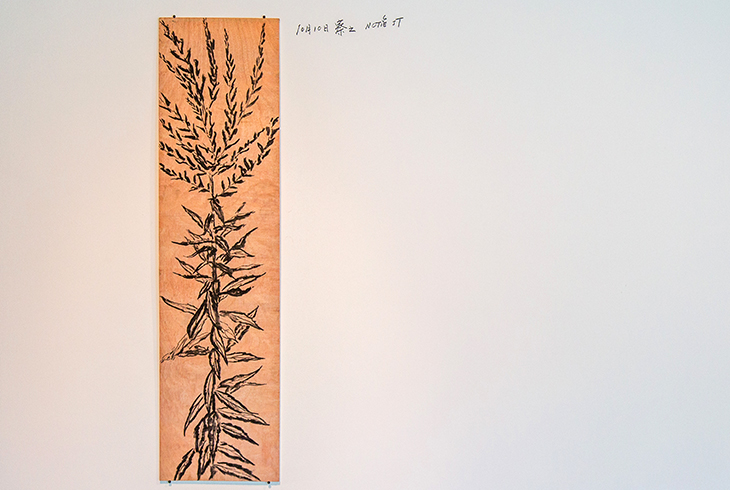
After a two-year hiatus, NYU Shanghai’s art gallery opened October 10 with a new name, the Institute of Contemporary Arts (ICA), and a new exhibition, Goldenrod, featuring works by Hong Kong- based artist and educator Zheng Bo. The three-part exhibition – including several works co-created by Zheng and NYU Shanghai community members – highlights the institute’s focus on collaborative research and experimentation in the arts. Gallery director Michelle Yeonho Hyun, has reimagined the ICA as a “research center” where visitors do more than just view art – they help develop and employ it as a medium for the exchange of ideas.
NYU Shanghai Magazine sat down with Hyun and Zheng Bo to talk about the ICA’s new direction and its inaugural exhibition.
Q: Shanghai is well-known for its art scene. How did you imagine the ICA within this context, and within the context of the university?
Hyun: In Shanghai, you have a lot of great private museums and a flourishing commercial gallery scene, but there are not a lot of spaces that can allow artists to really take risks. As an artist, you need to be able to diverge from the initial idea behind a work or collaboration – you need to be able to experiment.
We really wanted to create a unique transdisciplinary, research-oriented arts program that meshes with NYU Shanghai’s identity as an institution for education, research, and public engagement. So the two main questions that I think the ICA Shanghai will ask any of our artist collaborators are: “What are you working on now?” and “What do you want to make next?”

Installation View: Goldenrod, an exhibition by Zheng Bo . ICA at NYU Shanghai, 2019. Photo: Hong Xiaole.
Q: Why focus on “contemporary” arts here at NYU Shanghai?
Hyun: In the contemporary arts, we have the space to create works that may not look the way we initially thought they would, or that may not be received in the way we anticipated. Contemporary art also moves between different disciplinary concentrations, in much the same way as our lives and identities move between different tracks. So it explores the spaces between the niches and crevices that can come to de ne us in an educational institution.
Zheng: I think for me, art provides a holistic sphere to think about issues that cannot be addressed by specific disciplines. It’s a space to think about these questions that are very di cult to de ne, yet are very important and which require us as humans to use all our faculties and capacities to wrestle with them.
Q: Tell us more about Goldenrod. What is the exhibition named for?
Zheng: Goldenrod features two works by me – a lm series called Pteridophilia and a new drawing that I created just for this exhibition – as well as a collaborative project called Eco-Socialist Garden , NYU Shanghai (《生态 - 社会主义园, 上海纽约大学》) that was created in a workshop with NYU Shanghai community members, philosophers, ecologists, landscape architects, and other artists.
The whole exhibition is named for the Canadian goldenrod, which is a weed that is probably the most ubiquitous plant species in Shanghai. It’s kind of on the bottom of our plant hierarchy, but it’s also everywhere, so it’s also the most visible. It’s important for people who leave the exhibition to all of a sudden see these plants everywhere in their lives, to change our everyday practice.

Installation View: Zheng Bo, 72 Relations with Canadian Goldenrod, 2019. Photo: Hong Xiaole.
Q: Michelle, why did you select Zheng Bo’s work as the ICA’s opening exhibition?
Hyun: To reopen with an artist like Bo is hugely symbolic. His practice has a great deal of synergy with university art galleries as places for experimentation and research. Bo’s work embodies a different relationship with knowledge – he doesn’t purport to be an expert. Bo is very open to being the one who is learning rather than teaching. His workshop to create Eco-Socialist Garden, NYU Shanghai is a great example – the idea is to bring different people and collaborators together to generate art on a co-equal level.
Q: What’s next for the ICA after Goldenrod?
Hyun: Goldenrod launches our first two-year artistic research program which is called “The (Invisible) Garden.” It’s going to include projects with collaborators from all over the world.
Our programming is not just going to focus on visual arts – it’s more broad and inclusive of other forms or art and other sensibilities. Ultimately, the research cycle of “The (Invisible) Garden” looks at gardens as places for experimentation, but also as a way to sort through how our understanding of nature has been handed down to us through many different means. We want to inquire into the garden, not just as an aesthetic form for the “display” of nature, but a meaning-making method and process that construct our relationship to so-called Nature.
To learn more about the Institute of Contemporary Arts at NYU Shanghai and its featured artists, visit ica.shanghai.nyu.edu.

